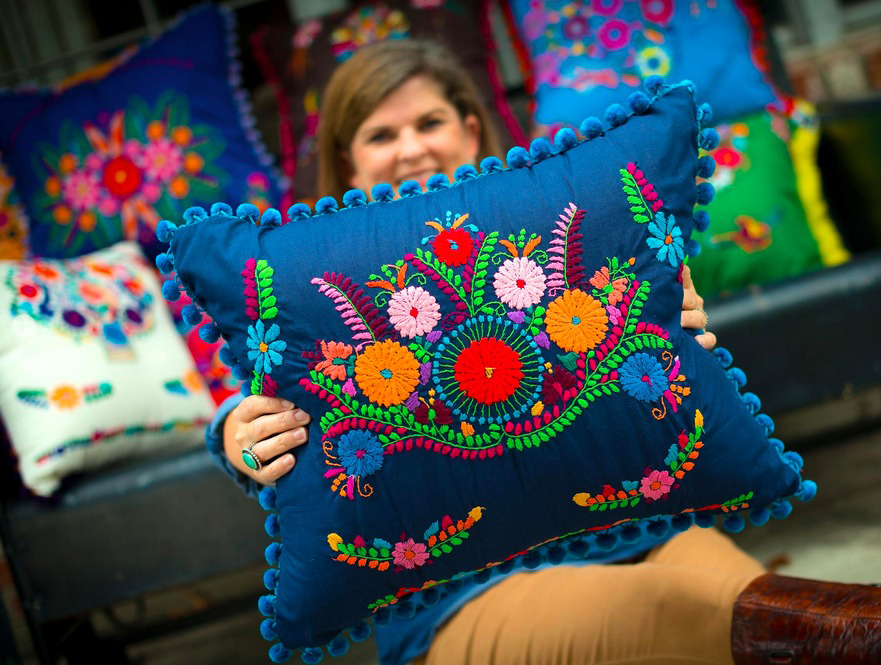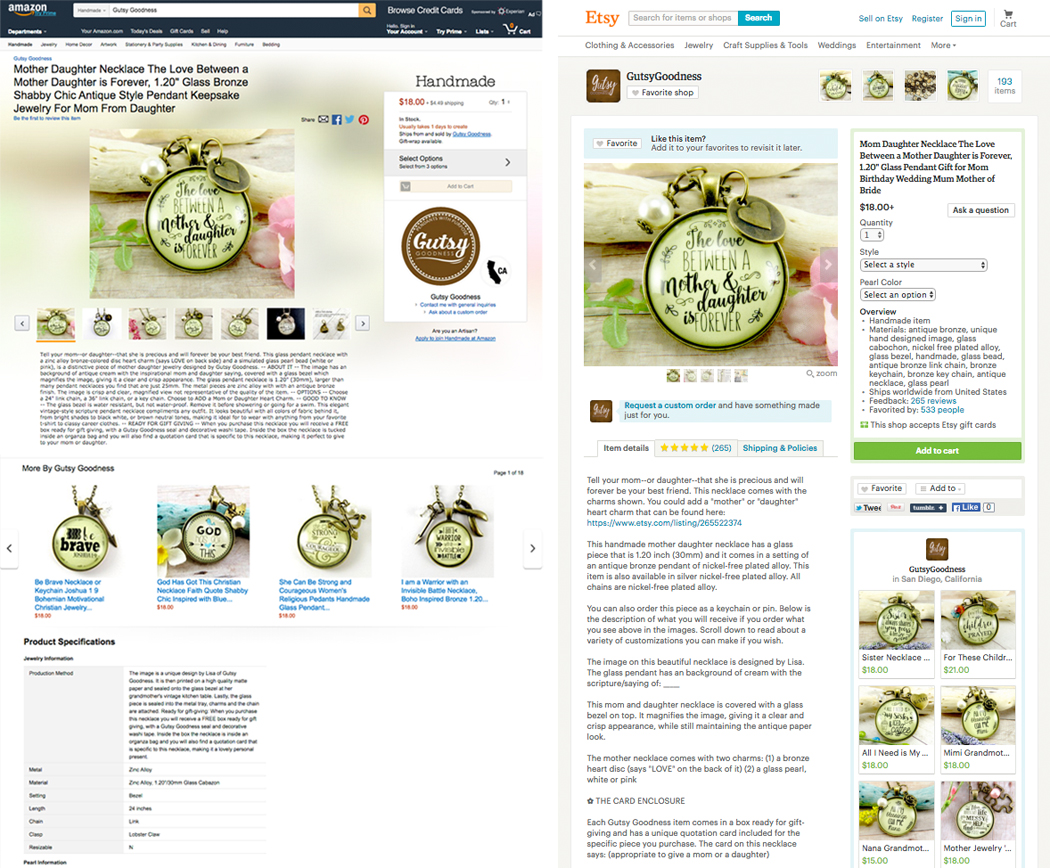
Pillow made from repurposed Mexican dress by The Bird and Pear.
Photo courtesy of The Bird and Pear
Handmade at Amazon has been live for six months and we wondered how crafters have fared. What is it like to sell handmade goods on Amazon? How does it compare to Etsy? We checked in with three creative business owners with shops on both platforms to find out.
Liz Leatherbury was in the first Handmade at Amazon cohort of shops. She repurposes Mexican dresses into handmade home goods such as can cozies, zippered pouches, pillows, and tea towels in her San Antonio studio. Leatherbury has a shop on Etsy, The Bird and Pear, and remembers how she felt when she first heard about Handmade at Amazon. “I was so excited. All this traffic and a tightly juried handmade marketplace? It sounded so good.” Leatherbury’s Etsy sales were steady, but she’d become frustrated with certain aspects of the Etsy ecosystem. “Etsy is just not all that well-policed. There are things on there that are obviously not handmade,” she says. She was hopeful that Handmade at Amazon would be the perfect storm of a high volume of traffic and tighter curation.
“I launched my shop on opening day and nothing. No views, no traffic, no sales. I worked on SEO, changed my titles, and took all new photos. Still nothing.” Leatherbury recalls. She was disappointed, but decided to hang in through the holiday shopping season in the hope that things might pick up.

Lisa Copen’s shop on Handmade at Amazon, left, and on Etsy, right.
Still, both women describe Amazon as less compatible with handmade goods overall because the Amazon customer has an expectation of instant gratification that can be especially challenging for artists whose work is one-of-a-kind. “As soon as an order comes in the clock starts ticking,” Leathery explains. “Even if it’s one minute before midnight, Amazon counts that as a whole day of your fulfillment timeline. If you have to make that item by hand, that’s crazy! But the Amazon buyer has been trained to want everything in two days.”
Kimberly Bart creates party supplies, such as gender reveal piñatas and crepe paper tassels, in her Portland studio. She has a shop on Etsy, Pom Joy Fun, and was eager to join Handmade at Amazon at launch as well. Although her Amazon sales are slightly outpacing her Etsy sales, she’s become disenchanted with the Amazon culture. “Amazon is really customer-centric. A person can return anything at any time for any reason no matter what the condition,” she says. If she creates a custom set of tissue paper tassels for a customer and it’s returned torn up she has to take it back even if it’s not salable. “Amazon doesn’t listen at all to the artist. On Etsy whatever your policies are, Etsy stands by you.”
Copen says that Amazon listings are difficult to optimize for readability. There are no paragraph breaks, and sellers can’t use HTML tags to create them, which means that listing appear as a solid block of text. If you need to explain how an item is handcrafted and what the options are for customization, that text can get rather long. “It looks really unprofessional,” Copen says, “like you couldn’t write a description that’s easy on the eyes.”
The user interface for sellers can also be difficult to navigate. Bart says, “Amazon is a mess. It was created by developers and engineers and you feel like they got it to where it was just good enough, figured they’d tweak it slightly later, and then just forgot about it.”

Kimberley Bart creates party supplies, such as this gender reveal balloon with crepe paper tassels.
Photo courtesy of Kimberley Bart
On Amazon, ad dollars are effective. Copen has purchased advertising on both Etsy and Amazon and reports that her ad dollars go much further on Amazon. “If I spend $100 on Etsy Promoted Listings I’ll get $200 in sales. I’ll spend $6 on Amazon ads and get $300 in sales. That’s a pretty big difference. Amazon ads really work in bumping you up in search.”
One of the exciting aspects of being on the Amazon platform is the ability to participate in Fulfillment By Amazon (FBA) in which sellers ship goods to Amazon’s fulfillment warehouses and Amazon fulfills each order.
“FBA defeats the purpose of anything one-of-a-kind or personalized,” Copen says. In addition, shop owners who want to gift wrap each order would need to do that in advance of shipping inventory to Amazon because Amazon will not apply any special wrapping to products.
Having made only three sales in six months, with “non-existent” sales at Christmas, Leatherbury decided to close her shop for good in February. “My appreciation for Etsy and what they are trying to do as a company has gone up after this experience,” she says. “Etsy has it nailed when it comes to handmade. It still drives me crazy, don’t get me wrong, but the attitude is different. Amazon is just instant gratification. It’s not an appropriate marketplace for handmade.”
Even Copen, who has had success on Amazon, says, “Amazon feels like going to a big box mall. Etsy feels like going to an artisan fair.” Bart concurs. “Amazon doesn’t get it. I’m not sure they ever will work on the things that are important to the handmade artist or ever understand us.”

Great article! I had forgotten about this Amazon division and haven’t looked around myself.
I’ve had mixed results with H@A. I was also part of the first wave of sellers, and on the first day that H@A went live, I sold two of the four quilts that I had listed in my shop. The next day, I sold the third. I was *so* excited, as these products had sat around on Etsy for months with no action…this seemed like *the* place to be. However, I haven’t had a sale since. So, definitely mixed results. I agree that Amazon was better at advertising H@A at the early onset, but much (much) less now. Also agree with Leatherbury that, unless folks know to scroll down the huge drop down list of categories to specifically search for “Handmade”, it’s very challenging for your products to be found.
I couldn’t agree with this more. I’ve gotten one sale of a handmade item on Amazon. This made me appreciate Etsy so much more that I bought stock in the company! I would love to learn more about advertising on Amazon though. I sell products in the non-handmade sections as well and I would love to try it out with them.
Thanks for the article, Abby. I do baby bibs, so until just last week I was not part of the invitation. Last week I got the invite in and I am really on the fence about it. The potential to reach more customers is awesome….but everything I have reservation about is confirmed here. Not to mention, Amazon shoppers not only want fast- they want cheap. Handmade is not in that category (and certainly my bibs are not cheap) and I wonder if my products are the right fit for Amazon. I need to sit on this longer, I guess.
I received an invitation for the first wave, but passed on it. Since I do made to order quilts, it didn’t make sense for me to go into Amazon. I’ve contemplated Etsy, but again, I’m not sure that would be a good platform for me.
I asked a friend who sells at craft fairs if she’d consider Amazon; she said she prefers the personal touch of the fairs.
Thanks for a great article, Abby!
I have to be honest, I was a bit dumbfounded about Amazon adding this offering. While I definitely see what they wanted a piece of the handmade pie (after all, total Etsy sales are attractive), it seems like a real ‘miss’ in terms of matching makers/artists/creators with their ideal customers.
Amazon’s customers want a big selection, the best price and super fast delivery – Amazon has trained us to expect all of the above!
How on earth does that match up with the handmade/maker community?
Additionally, I saw NO advertising for this new offering and I am not only an affiliate for Amazon, but a long-time Prime member.
I certainly wish everyone all the best in selling through Amazon, but I wouldn’t do it if I was making handmade items to sell.
Steph
It is not for everyone or every business. Despite putting all of my proven best sellers there in my shop exclusively I sold only 3 things in 6 months. I decided if I was going to do ads promote etc I was going to do it for my own website and decided to close. They got the media attention with handmade for a nanosecond and that was about it. You product is filtered in to the whole mix.
Great article Abby, thank you. However I don’t understand why it’s titled “H@A at Six Months” because it launched on October 2015 like you stated?
Anyway, please don’t be turned off to the possibility of H@A being a great online selling platform for you. Yes, it’s not for everyone, but it’s perfect for some of us.
I have sold my retro-inspired handmade seasonal decor on Etsy since 2009 and I love it for all the reasons everyone else does. But it has grown to a point where it has become harder to stand out and get seen. That’s okay, we just learn better ways to stand out. All good.
I’m 58 years oldish and tired of lugging my booth and wares to craft shows. I’ve been down the wholesale route and don’t want to travel cross country for weeks at a time, (leaving my family) to sell at gift shows. Online selling is all I want to do now. (Someday you youngins will understand.)
In comes H@A as another potential online selling venue that could reach a different kind of buyer. I jumped at the chance! Not because I was unhappy with Etsy, but because it’s another market.
I have both OOAK hand-embroidered items and easily reproduced items on both venues, and my Amazon customers have been as kind and patient with me as my Etsy customers. I refuse to do free Prime shipping. I give myself a reasonable manufacturing time and I charge for shipping. Maybe I’d do better with free shipping or a 1 day turnaround but that’s not what I do. And guess what? I do equally as well on H@A as Etsy!
H@A has doubled my income and I couldn’t be happier. Maybe it’s right for you too? Happy sales everyone!
Hi Robin,
This article was written in April when Handmade at Amazon was six months old. Thank you for sharing your experience. That’s great to hear!